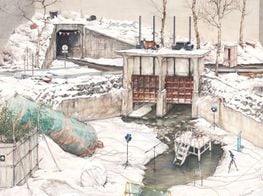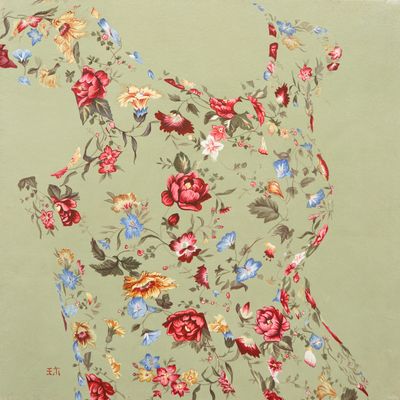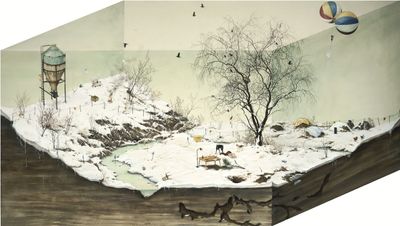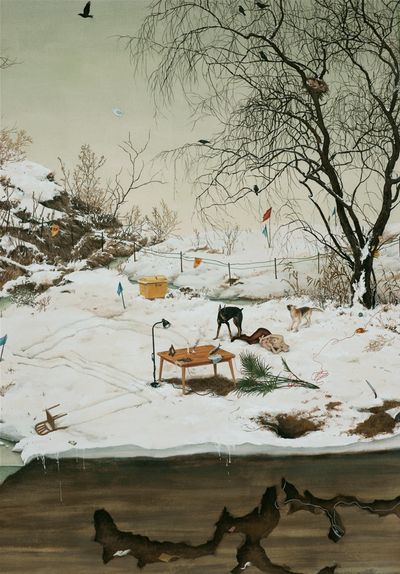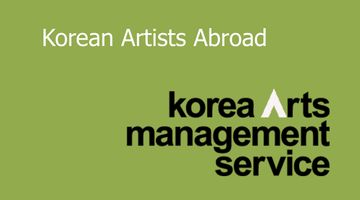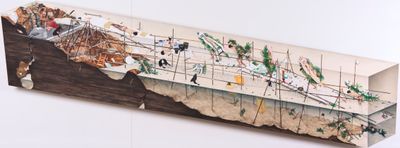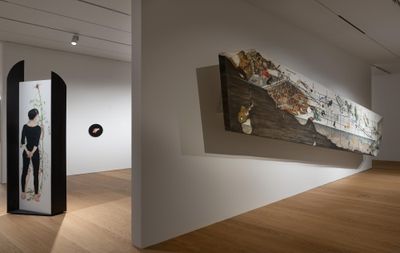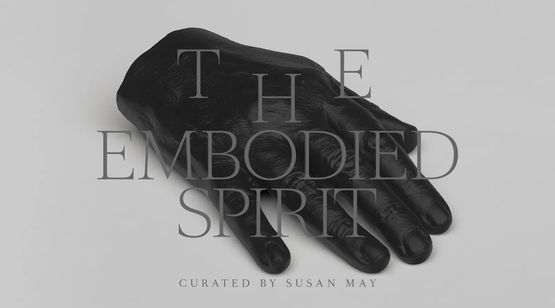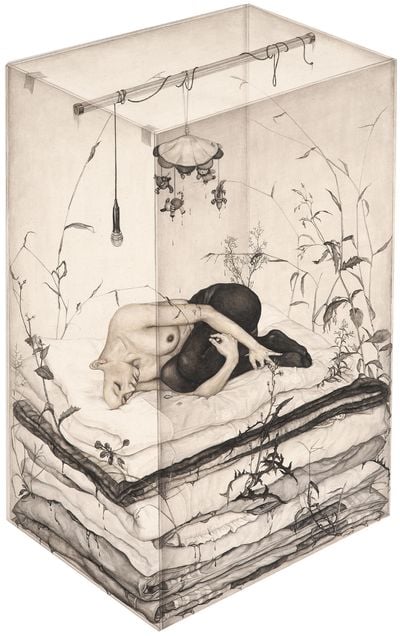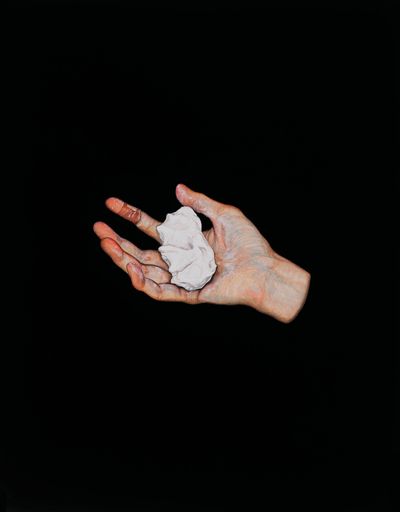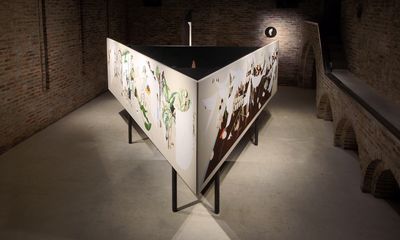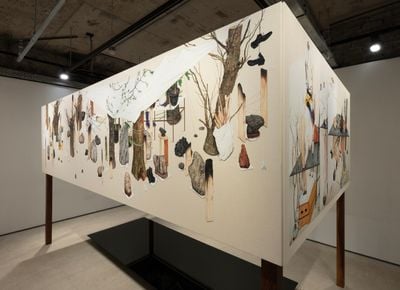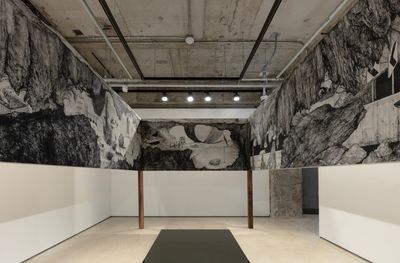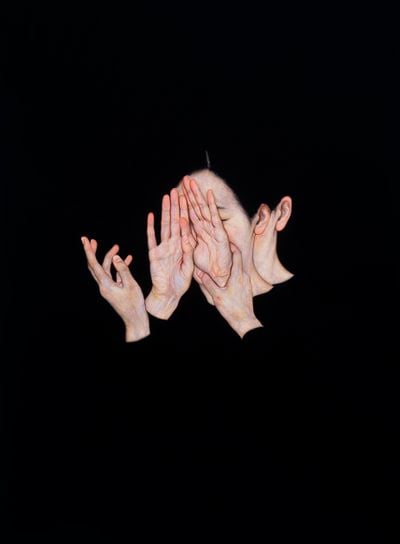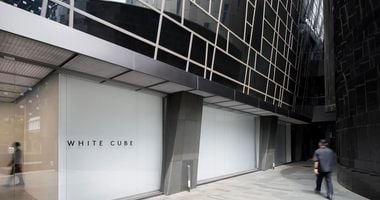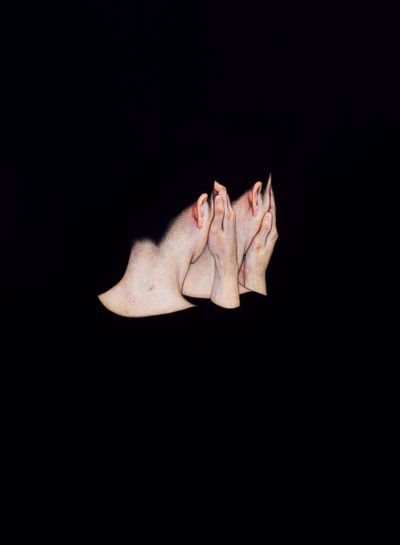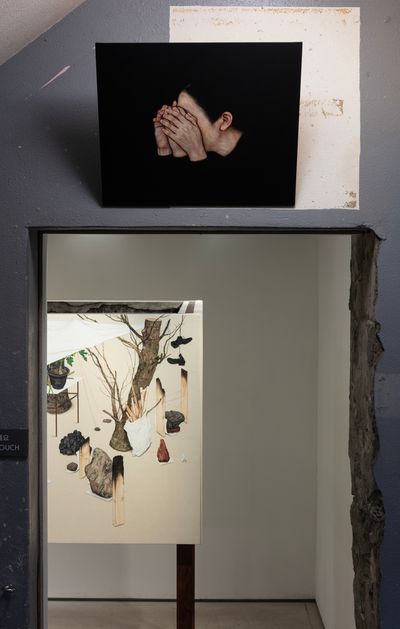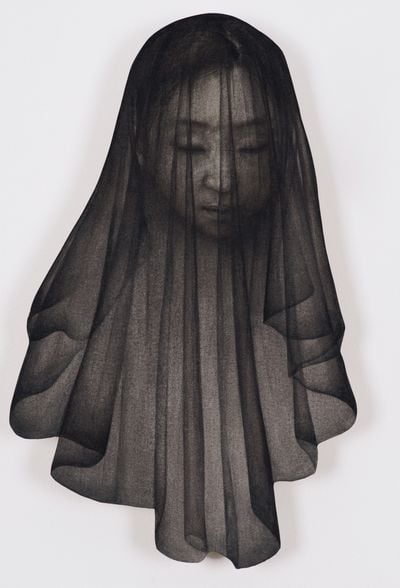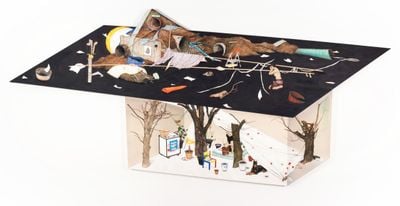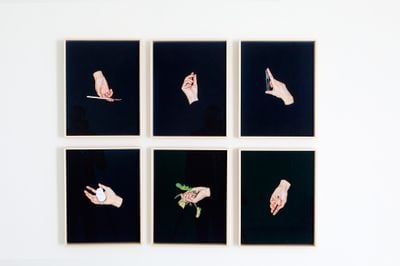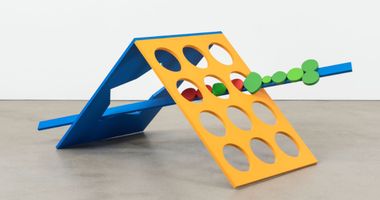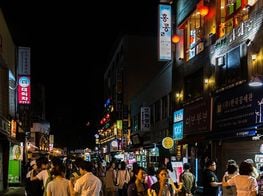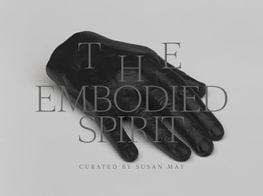Lee Jinju on the Subjectivity of Seeing
IN PARTNERSHIP WITH KOREA ARTS MANAGEMENT SERVICE
Lee Jinju, 읽을 수 없는 (2023). Powder pigment, animal skin glue, and water on unbleached cotton. Courtesy the artist.
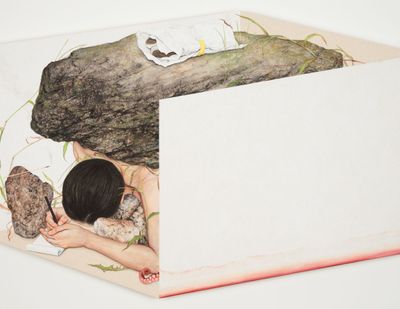
Lee Jinju, 읽을 수 없는 (2023). Powder pigment, animal skin glue, and water on unbleached cotton. Courtesy the artist.
Lee Jinju is a painter of memory. Fleeting impressions and old traumas, daydreams and observations, and private sensations congregate in her work as unlikely combinations of ordinary actions and objects.
If Lee's paintings recall the uncanny logic of dreams associated with Surrealism, the artist is less concerned with unlocking the subconscious than she is with revelling in the inconsistencies of memory and subjective experience.
The Busan-born artist's concerns have developed alongside an ongoing interrogation of her materials. Lee initially worked with oil paint, but soon discovered that she did not agree with the smell. Then studying at Hongik University in Seoul, where she received her BFA (2003) and MFA (2014), she began experimenting with powder pigments used in Korean traditional painting.
'I wasn't thinking so much about traditions or the Korean identity,' she said in a 2022 interview. 'It was more personal in that I wanted to keep on "touching" the pigments as I felt them transfer to the surface of paper from the tip of the brush.'
In her first solo exhibition Patternholic at Gallery DOS, Seoul (2006), the artist showed works on jangji (mulberry paper) depicting bright, flower-patterned clothes. Though invisible, the presence of bodies is palpable in Lee's practised execution of curves and volumes, evoking both the sensation of putting on a piece of clothing and the internal processes that go into choosing what to wear.
Such private, psychological experiences give form to Lee's paintings, which are inhabited by human figures, animals, plants, objects, and pieces of land—familiar representations that appear peculiar when brought together without a cohesive narrative.
In the snowy landscape of A way to Remember (2010), dark birds perch on tree branches in place of leaves, surrounding a nest holding an infant. Signs on the fence read 'danger'. A topless woman, wearing only a pair of pantyhose, holds a child close to her on the ground. Two dogs stand nearby.
Trails in the snow reveal that a chair was dragged some feet away from a wooden table, on which lay a candle, fish, a framed photograph, and a knocked-over bottle. While all these individual parts derive from her observations, the logic (or the lack thereof) of memory for Lee is such that specificity and linearity lose meaning when recalling their images. By this time, Lee had moved away from jangji to settle on unbleached cotton as paper did not allow revision.
In A way to Remember, the landscape is contained within a cuboid-shaped canvas with translucent walls, positioning viewers outside the miniature world. One may be reminded of looking into fish tanks with elaborate ornaments found in many Korean seafood eateries—those quiet, ungraspable worlds that operate by their own rules.
The Lowland (2017) takes a bolder form, measuring up to 5.5 metres in width, that reflects the shape of the inclined lowland it houses within. Women in pantyhose carry large flower wreaths on their backs—the kind typically used in weddings and funerals in Korea—towards wooden scaffolding uphill, where lies debris, broken furniture, and a dog.
The Lowland is currently on view in PANORAMA, a group exhibition of 16 artists at SONGEUN, Seoul (16 August–28 October 2023). It is one of the three concurrent group exhibitions in Seoul featuring Lee's work alongside The Joy Wandering in the Landscapes at SunGallery (30 August–14 October 2023), curated by art historian Kim Yi Soon, and the inaugural exhibition of White Cube Seoul, The Embodied Spirit (5 September–21 December 2023), curated by Susan May, Global Artistic Director at White Cube.
Outside Seoul, Lee is having an exceptionally full year with works in the group show Oriental Painting: Already Always Ever Changing at Art Center White Block, Paju (14 July–9 October 2023), and the solo exhibition Confined Composition Part 2 at ARARIO Museum Jeju Tapdong Cinema (31 August 2023–7 July 2024), where Lee examines the limitations of seeing by constructing a large, four-sided installation of paintings that almost takes up the entire exhibition space.
A new group exhibition, titled Goodbye to Love: Conversation of all those whose lips are sealed, is also open at Marres, House for Contemporary Culture in Maastricht (1 October 2023–7 January 2024), with works by Lee, Hyesoo Park, and James Webb.
Conversation of all those whose lips are sealed borrows its title from Lee's 2012 painting, a greyscale work depicting a woman lying on a stack of blankets inside a transparent box—also the shape of the canvas—from which plants sprout. As with Lee's other works, the specific yet disparate imagery triggers a string of associations that may include resting, loss, sorrow, birth, and death.
Lee's 'Black Paintings' (2017–ongoing) series is included here and in her other presentations. In the paintings, faces and hands emerge from a black background, frozen or referring to actions. In Whole (2023), a single hand holds up a piece of dough. Imprints of fingers in the paste, along with traces of flour on the palm and a bandage on the forefinger, simulate physical motion and pain.
In this conversation, Lee discusses her recent works, the act of seeing, and the ordinary moments that catch her attention.
SPYou have often talked about your fascination with memory. Could you also elaborate on your thoughts on seeing, which always seems to be denied to a degree in your work?
In the A-shaped painting installation The Unperceived (2020), which was also the title of your solo exhibition at ARARIO Museum in Space, Seoul, in 2020, the paintings could never be seen at once; in the 'Black Paintings' currently on view at White Cube Seoul, faces turn away from viewers or hide behind their hands.
LJJWhat does it mean to 'see'? I am very interested in what we see beyond what's available in physical, three-dimensional spaces, beyond the phenomenon. What an individual sees, if it were to be cognised and interpreted, will surely appear heavily subjective and incomplete.
In the beginning, I was interested in what triggers memories like unwanted trauma in ordinary and recurring moments. I began to think that the seemingly universal within daily lives, the objects and situations, differ by person. The tiniest clues or correlations could expand the sight before us to a range of thoughts, memories, imaginations, and emotions.
To me, figurative representations that originate from reality are a world of infinite symbols or clues. The Unperceived attempts to reveal the unperceivable by adopting painting as a sculptural structure, and I was painting about things we cannot see but exist.
Confined Composition Part 1 (2022) and Part 2 (2023) go further than that, organically connecting the exhibition space and the work. In the small exhibition space, the painting installation feels like another room. The space between the wall and each side of the installation is about 70 centimetres, which allows only one person to pass through.
The viewer must move through that narrow space to see the horizontal paintings. They could walk backwards to see the painting better, but it'll only be a step or two, and their perspective won't change by much. The world we see is like this—it's made up of narrow parts. We cannot see the whole, and the view would be distorted even if we stood in the corners. A different scene emerges when you turn around the corner, but this means you can't see what came before.
In Confined Composition Part 2, I even added several scenes to the black-and-white, cave-like landscapes inside the installation. It's a painting you can't see from the outside, and one that exists that way. On the floor, there is a black mirror in the shadows of the work. From certain angles, you might see warped reflections of those grotesque landscapes, which took many hours to complete.
When we conjure the earth in our minds, I wonder whether we imagine the world through an incomplete reconstruction of parts and fantasy. I wanted to create a visible structure through which viewers experience the approach we take with the limited world we see.
The paintings at White Cube Seoul reference the act of 'seeing' in a more focused and suggestive manner. Instead of painting the eyes, which correspond directly to seeing, I opted to conceal them or paint the back of the figures instead. I was also thinking about a 'sightless' relationship between these two entities, who could be the two of an ego or an ego and the other, that stand very close to one another.
Or there are images with a finger in the ear, where I was thinking about perception. With these works, I was contemplating paradoxical acts and passivity-activity that have to do with phenomenal scenes that we access through sight or those that lie beyond vision.
SPExhibitions like Confined Composition Part 1 and 2 trigger a greater awareness of one's body by restricting the space it is allowed. Would you say that the viewer's experience now plays a larger role in your practice? Might this be a direction that you explore further in future projects?
LJJAs I've said earlier, it's an expansion of 'seeing'. Painting is the oldest form of classical art. I've thought a lot about how this quiet, still, and familiar medium could appear special to viewers within contemporary art, where there are so many new, active ways of seeing an artwork.
It's important to me that my works do not end up being products of self-expression and seeing but can reach out to other people and find meaning in the world.
Having said that, how my paintings appear to viewers in a physical space needs to be carefully and meticulously planned. That is probably why I began working with shaped canvases and sculptural paintings, where even the conventionally shaped canvases have angular sides so that only the frontal image appears to viewers, concealing the canvas' thickness.
The exhibition space and the physicality of viewing were especially important for Confined Composition Part 1 and 2. I was struck by the space when I first entered it—there was a different exhibition then, where the works were being shown in the usual way, that is, mounted on the wall—and my husband Lee Jeong Bae strongly suggested the concept of an installation that would fill the room.
I'm not sure how the viewer's bodily experience might be integrated into future works. But it might be applied in different forms depending on the kind of impression I get from a space, or if Lee has an idea I could work with. I am keen to portray the distinctiveness of my work and narratives within its space, which feeds into actively seeking ways of occupying the exhibition space. This would naturally give rise to experimenting with how people experience, perceive, and interpret the work.
SPSome of the works selected for Goodbye to Love were painted almost a decade apart. How did you select them, and how have your approaches to the composition of an image changed over the years?
LJJBecause it is my first exhibition in the Netherlands, I wanted to show different forms of my practice and narrative while considering the exhibition theme, 'Goodbye to Love', which I interpreted in terms of loss, mourning, consolation, separation, and relationships.
Layers of Daytime (2014), in particular, is a shaped canvas painting that reassembles parts of snowscapes in Paju, where I live. It's a work that reflects both the ordinary and odd atmosphere of my early compositions. I used to be very fond of Flemish painter Pieter Bruegel's works, which are filled with different narratives. In Goodbye to Love, some paintings deal directly with loss and mourning, like Darken (2014) and Between (2015).
The earlier works in the exhibition reference certain memories and emotions, and situational narratives that are more specific. There are also stage or installation-like still lifes. Around that time, I was also working with both conventional and shaped canvases. Between is one such work, given curves that show an active attempt to experiment with the canvas' shape. In Four Questions (2019), by comparison, two different landscapes are put together in an odd, pointed shape.
SPTo make the 'Black Paintings', you first paint the hands and faces before applying black paint to the surface. What led to this process? Do you perceive the work differently after the black paint?
LJJThere are two reasons. First, it's practical to draw the body parts before painting the black space because the special Leejeongbae black [that the artist and her husband developed] I use is made with a minimum amount of binder and is prone to contamination. The body requires a long time to paint, so black goes on in the end.
The second reason has to do with meaning. The 'Black Paintings' leave out the body in fragments, and everything else is covered in black. When you see the work in person, the black is not a smooth and consistent surface, but consists of more velvety, powdery stains that repetitively cover the blank space.
What's interesting to me is that the hands and faces don't feel particularly special when it's just the acrylic. But as soon as I paint Leejeongbae black, it suddenly feels as if the same figure comes alive and attains special power! It could be that the black paint is too saturated, which makes the contrast stronger. But I can't explain why that contrast—as well as the velvety pigment—gives off a stronger, special impression.
SPYou have said that you are drawn to ordinary moments that suddenly feel uncanny or unfamiliar. Would you share one such moment that happened recently?
LJJFor example, a stone. On a short vacation, I saw a stone submerged in water. It was an ordinary stone, but it made me think about a lot of things—its history, the time and space it lived through to become what it is now. Those sensations feel as though they've become another symbolic object in my life.
Or it's a moment from life. This was a while ago, but when you're raising children, you're met with completely unexpected words or behaviour. One day, my daughter, who was in kindergarten at the time, came over to me and put her finger in my ear. No one had ever put their finger in my ear before. It left an impression on me. Things like these I draw, and they are used as sources or situations when I'm making large-scale works. Or they become gestures—like someone covering their ears—in my paintings.
SP2023 has been quite a full year. What's next for you?
LJJThis summer has been a time for just painting and exhibitions. For now, I'm not planning on doing many exhibitions; I want to focus on long-term paintings. I'd also like to continue to study Eastern philosophy, in which I hold a doctorate, and write. —[O]

